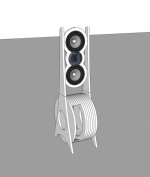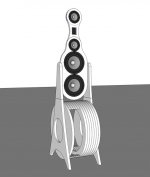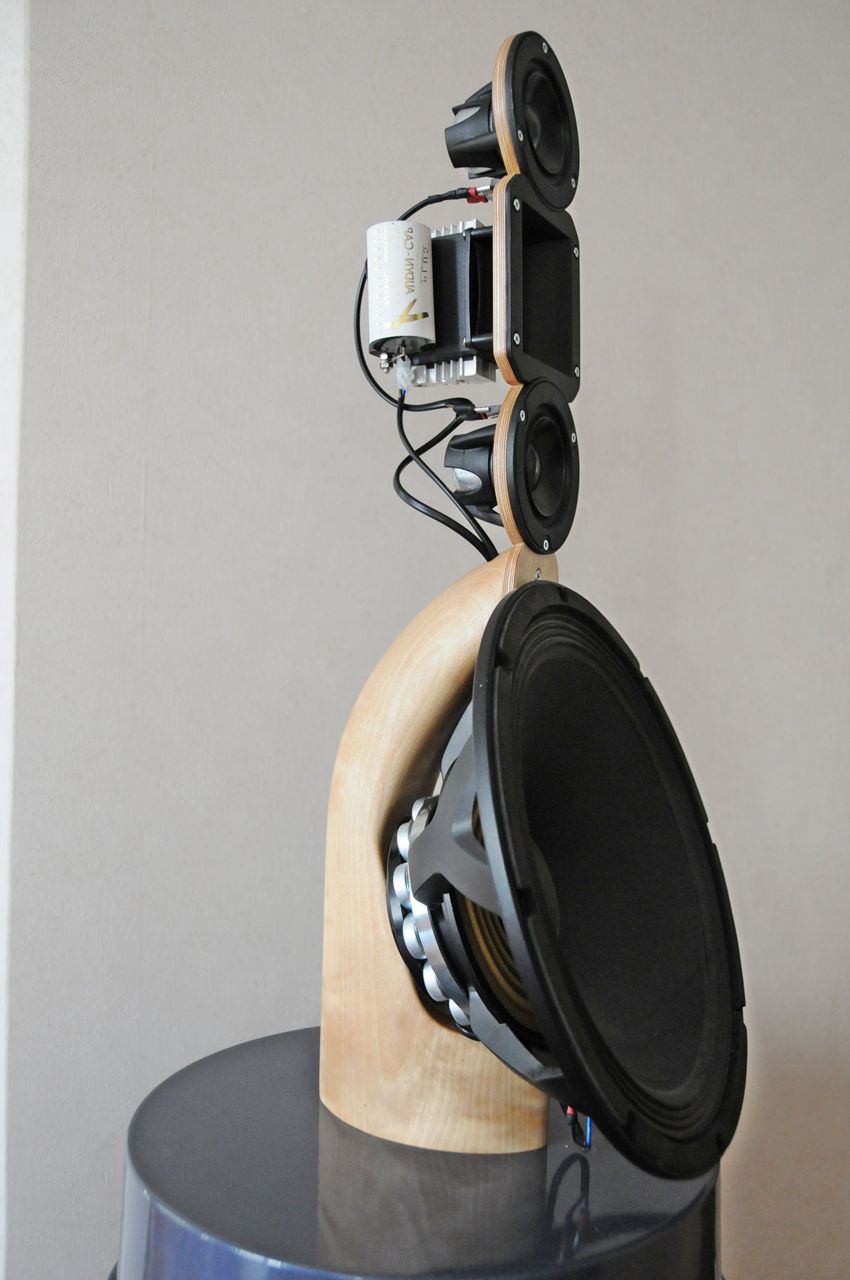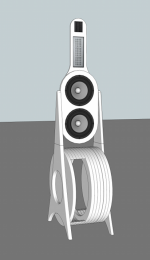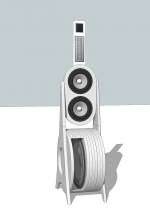If you can export your impulse response measurements as .wav files, I could turn them into polar plots or sonograms for you using ARTA.
I'll try to do that this week.
Juhazi said:And what xo frequencies you use, what topology?
From the top of my head: 130Hz and 1600Hz, all 24dB/oct.
I think it should be easy to eq the woofer even more (flat to 30-35?) , but perhaps at the expense of overall "efficiency" Be careful for not boosting low end, because without high-pass it leads to digital clipping in minidsp.
I catually already have a big problem with this. Since mid and low need a fairly big boost (I think the low end has about 20dB boost right now, probably far to much), I needed to turn down the levels of those channels significantly to prevent digital clipping. This has the nasty side effect of not being able to play very loud right now. The 0dB setting of the miniDSP is just not loud enough to make me fall of my chair
I think I'll need to make the amps with adjustable gain, so I can give every channel the most optimum gain possible. I guess, three variant should be enough: 1x, 2x, 4x. Currently I only have a unity gain LM4562 buffer in front of the L25D's because the miniDSP cannot drive the amp directly very well. It should be an easy fix to add a dip switch to change gain.
I also came up with an improved design yesterday. It should solve the problem of the vibrating bass section, but I can't seem to get a nice way of clamping the magnets without obstructing the NEO3. I came up with a different approach by clamping the mid/tweeter section, sort of like a H baffle. I don't like it yet however, so it needs more work. The bass section is now completely round, and will also be clamped and suspended between de sides using rubber o-rings (and some way to hold it together).
Attachments
I use 4x10Hd too. Have you adjusted the dip switches inside the box? Mine came with low sensitivity input settings. Both input sensitivity and output level are selectable (for balance/unbalanced)! User manual http://www.minidsp.com/images/documents/miniDSP%204x10%20User%20Manual.pdf
The side panel will harm your horizontal polars, original concept is much better! Does the Neo3 have it's back plate on - then it doesn't radiate backwards.
xo's are propably ok for this system. I expect there will be quite high energy above 1600Hz when mearured 15¤ and more sideways ( bump in power response). That can't be fixed electronically (4-way or tweeter with a horn is needed). The meaning of this remains a question and depends on your room too.
The side panel will harm your horizontal polars, original concept is much better! Does the Neo3 have it's back plate on - then it doesn't radiate backwards.
xo's are propably ok for this system. I expect there will be quite high energy above 1600Hz when mearured 15¤ and more sideways ( bump in power response). That can't be fixed electronically (4-way or tweeter with a horn is needed). The meaning of this remains a question and depends on your room too.
I use 4x10Hd too. Have you adjusted the dip switches inside the box? Mine came with low sensitivity input settings. Both input sensitivity and output level are selectable (for balance/unbalanced)! User manual http://www.minidsp.com/images/documents/miniDSP%204x10%20User%20Manual.pdf
Yes I know. I didn't open the box yet, because default should be high sensitivity (so 2VRMS), and that would fit the 1.6V of my amp just fine. I'll have a look at the switches now though
The side panel will harm your horizontal polars, original concept is much better! Does the Neo3 have it's back plate on - then it doesn't radiate backwards.
As I said, I don't like it either
xo's are propably ok for this system. I expect there will be quite high energy above 1600Hz when mearured 15¤ and more sideways ( bump in power response). That can't be fixed electronically (4-way or tweeter with a horn is needed). The meaning of this remains a question and depends on your room too.
I can imagine you are right there. The flat on-axis response yield in a fairly bright sound. I'd like it bit less bright, and I would expect it to be so judging by the response. Could I solve this by using an extra pair smaller mids to push the tweeter x-over point further up? It would be a 4-way SWMTMW then.
Last edited:
Yep, directivity control is very difficult with dipole systems (narrow passbands), sorry! This is why S Linkwitz, J Kreskowsky and Gainphile went 4-way - and me too with AINOgradient. Actually a 4-way with a horn-loaded tweeter.
http://www.diyaudio.com/forums/atta...aborative-speaker-project-aino-high-ref-s.jpg
But you can do the waveguide trick instead and keep 3-way! This thread lifted up the 8" oval double waveguide with a ribbon tweeter. Waveguide helps with directivity and low-end extension both! Distance between mids will grow a little but it might be tolerable. The question is how low you can go with Neo3 openback (power handling, distortion)
http://www.diyaudio.com/forums/mult...ve-guide-speaker-lots-pics-4.html#post3609019
http://www.diyaudio.com/forums/atta...aborative-speaker-project-aino-high-ref-s.jpg
But you can do the waveguide trick instead and keep 3-way! This thread lifted up the 8" oval double waveguide with a ribbon tweeter. Waveguide helps with directivity and low-end extension both! Distance between mids will grow a little but it might be tolerable. The question is how low you can go with Neo3 openback (power handling, distortion)
http://www.diyaudio.com/forums/mult...ve-guide-speaker-lots-pics-4.html#post3609019
Well, a waveguide is not really a problem. I have the room for it, and I wasn't going to use the front plate anyway.
A 4-way design is just going to be to large, and also add extra cost. I guess a Neo 8 would be doable budget wise, but it doesn't really fit the visual design.
But I'll first do some more measurements, and then we'll see how large the problem really is.
Meanwhile, I can think about the final design some more
A 4-way design is just going to be to large, and also add extra cost. I guess a Neo 8 would be doable budget wise, but it doesn't really fit the visual design.
But I'll first do some more measurements, and then we'll see how large the problem really is.
Meanwhile, I can think about the final design some more
I ended up with a 4-way as well, or you could call it a 3-way with an H-baffle subwoofer.
The main problem is to find a small enough dipole tweeter in order to maintain good directivity, but a tweeter small enough for 20 kHz does not exist. I used the Mundorf AMT2340 without frontplate. The directivity was good up to about 6 kHz, which is quite good.
A design like mine shown on the pic below will have good directivity in the horizontal plane, but the vertical plane is a total mess.
The main problem is to find a small enough dipole tweeter in order to maintain good directivity, but a tweeter small enough for 20 kHz does not exist. I used the Mundorf AMT2340 without frontplate. The directivity was good up to about 6 kHz, which is quite good.
A design like mine shown on the pic below will have good directivity in the horizontal plane, but the vertical plane is a total mess.
An externally hosted image should be here but it was not working when we last tested it.
StigErik, I have followed your projects for a long time. What is your personal opinion of the audibility of vertical variations and is there a "real" problem with vertical lobing/combing in these multiway speakers? Supposing we think in context of home environment, not concert venues/ long distance PA.
Like someone said earlier, lobing and specially directivity can be beneficial too, to minimize floor reflection eg. - the mostly used "beneficial effect" Your line of 4 woofers is a directivity cannon! Did you do it because of that or just for sensitivity/distortion management?
Like someone said earlier, lobing and specially directivity can be beneficial too, to minimize floor reflection eg. - the mostly used "beneficial effect" Your line of 4 woofers is a directivity cannon! Did you do it because of that or just for sensitivity/distortion management?
Well, why do we seek good directivity to begin with? If it didn't matter, all we should do is optimize the on-axis response....
Yes I do think uneven off-axis response is audible, not just in the horizontal plane, because the room reverb/decay will be less linear.
But the biggest challenge is the floor and ceiling early reflections. These are difficult to avoid, and difficult to treat (especially the floor). They will not be anyway close to linear in frequency response either, and will in any case cause coloration and strong comb filtering of the response at the listening position. That is why I prefer a line source, because it practically eliminates the floor and ceiling reflections.
The four woofers in my design show above has no directivity benefit, since I XO at ~500 Hz. It does not start to beam in the vertical plane until above the XO point. I used four woofers to get better sensitivity and more SPL, and of course less distortion. I also reversed two of the woofers and one midrange to get reduced even order distortion, as shown below.
Yes I do think uneven off-axis response is audible, not just in the horizontal plane, because the room reverb/decay will be less linear.
But the biggest challenge is the floor and ceiling early reflections. These are difficult to avoid, and difficult to treat (especially the floor). They will not be anyway close to linear in frequency response either, and will in any case cause coloration and strong comb filtering of the response at the listening position. That is why I prefer a line source, because it practically eliminates the floor and ceiling reflections.
The four woofers in my design show above has no directivity benefit, since I XO at ~500 Hz. It does not start to beam in the vertical plane until above the XO point. I used four woofers to get better sensitivity and more SPL, and of course less distortion. I also reversed two of the woofers and one midrange to get reduced even order distortion, as shown below.
An externally hosted image should be here but it was not working when we last tested it.
Directivity control in dipole systems is easy as pie - if you stick to the rules! Admittedly those rules don't allow massive cone areas in a 3-way system. When people go for 4-way systems, this is mainly driven by high SPL demands on their behalf.Yep, directivity control is very difficult with dipole systems (narrow passbands), sorry! This is why S Linkwitz, J Kreskowsky and Gainphile went 4-way - and me too with AINOgradient.
4real has this problem in the midrange section. It always shows first in the midrange section. I compare his measurement with the Edge sim (red line) of his baffle:
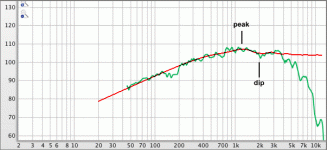
We can easily identify the dipole peak and dip region. From theory we know that the off axis response curves will converge between the peak and the dip - resulting in a blooming of the off-axis response. It is easy to predict a rather blatant response for the area around 2 kHz.
The best remedies would be to either
- cross below 1.5kHz (which either demands an AMT tweeter or leads to a 4-way system) or
- reduce the size of the midrange drivers to (baffleless)12 cm instead of the HDS180. Obviously this solution would reduce the maximum SPL capability.
BTW: I see a reverse problem for the crossover between woofer and midrange. The upper frequency limit for the woofer needs to be exploited. Presently the crossover point is way too low for a 3-way system.
Rudolf
Hmm..
I could imagine a design like this SWWMT. This would simplify construction a lot, and retain the visual design somewhat. I would loose the MTM. The question then would be what mid I would add? I might have some candidates:
- Visaton TI100
- Peerless/Vifa NE123W-04
- B&G NEO8 (S). This one is a bit harder to make fit in visually
I could imagine a design like this SWWMT. This would simplify construction a lot, and retain the visual design somewhat. I would loose the MTM. The question then would be what mid I would add? I might have some candidates:
- Visaton TI100
- Peerless/Vifa NE123W-04
- B&G NEO8 (S). This one is a bit harder to make fit in visually
I really like this design. Compact and aesthetical
It should be possible to decouple the bass section completely (not attached to the "midrange baffle") ?
I use Sketchup for drawing. The basic version is free, and is very easy to use once you've got the hang of it.
Yes, I could decouple the bass section completely, but I really want it to be one unit. And this way, the bass section is floating of the ground, making it look quite cool.
I will add another design later today, with a NEO8S in stead the a 4" woofers from the last incarnation.
Yes, I could decouple the bass section completely, but I really want it to be one unit. And this way, the bass section is floating of the ground, making it look quite cool.
I will add another design later today, with a NEO8S in stead the a 4" woofers from the last incarnation.
Neos should be worth the price! The looks suffers a little because they are not round. But I really like your basic form! Perhaps the front plate of Neos' could be painted (white?) with a sponge...
I am sure you fill find the looks, you certainly have an eye for that!
Juha!
I am sure you fill find the looks, you certainly have an eye for that!
Juha!
Yeah.. why not make the whole thing from gold.. The thing is, the Neo 10 is twice as expensive as a Neo 8S, and more than 400 euro's more expensive than four Dayton RS100-8's.. That is a lot of money I could also spend on CNC and a decent paintjob.
I think a Neo 8 is about the limit here.
Anyway, my wife hates the design with the Neo 8, and loves the other one with the RS100 (and I didn't even tell her the difference in price yet ). And I agree with her: I really don't like the way it looks right now.
). And I agree with her: I really don't like the way it looks right now.
I thought of making putting the NEO on a 10 mm anodised aluminium front plates, like you can get here. It will break the shape even more than the current design, but maybe, that is exactly what it needs:
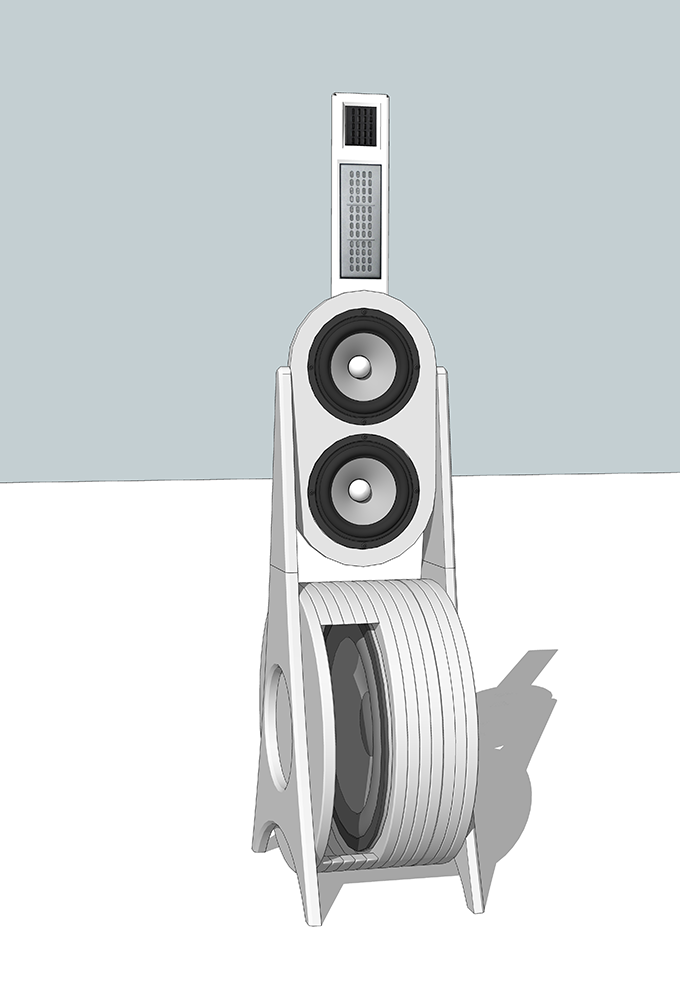
This is better already, but I'm not sure she will like this
I think a Neo 8 is about the limit here.
Anyway, my wife hates the design with the Neo 8, and loves the other one with the RS100 (and I didn't even tell her the difference in price yet
I thought of making putting the NEO on a 10 mm anodised aluminium front plates, like you can get here. It will break the shape even more than the current design, but maybe, that is exactly what it needs:
This is better already, but I'm not sure she will like this
Attachments
Just came to my mind that the bass should have same volume in each chamber. To do that - Take off discs from left and move them to the right (magnet side)
I think you must invent something for the mid-tweeter frame.. Your wife has an eye too! I had to go on working with Ainos for three months before I got the permission to carry them to the living room!
I think you must invent something for the mid-tweeter frame.. Your wife has an eye too! I had to go on working with Ainos for three months before I got the permission to carry them to the living room!
Just came to my mind that the bass should have same volume in each chamber. To do that - Take off discs from left and move them to the right (magnet side)
Yes, I was wondering about that. Most design I saw, had a smaller volume on the back side. I'm not really sure that I want to reduce the mouth on the front side even more. It's now about 1/3 of the driver SD.
I think you must invent something for the mid-tweeter frame.. Your wife has an eye too! I had to go on working with Ainos for three months before I got the permission to carry them to the living room!
She'd better have an eye for that kind of thing
So, I think I'll squeeze the most out of the design using the midwoofer. I really like the loos, and so does my wife.
On that front, I found some more driver that would be worthwhile I think. Price will determine MTM or MT
- As already said before, Dayton RS100-8 in an MTM. They should behave nicely and have low distortion
- Monacor SP-4/60-PRO. Should have very low distortion and at 27 euro's it a bargain. I'm not sure about off-axis response though. At that price, MTM is no problem. Also the quite high Qts might help.
- Beyma 5G40Nd. It's a 5" woofer, but according to the spec sheet excellent off-axis response and very low distortion. It's about 100 euros, so this one I would use as a MT, making the design a bit more compact. It's also a very efficient unit at 93 dB
- BMS 5N160. Also for MT, about 130 euros.
- Faital Pro 5 FE 120 A. Not very expensive, and looks like it has a nice response. Since it is a 5" unit, I'd opt for MT
Note that the last mids are PA woofers. Why? Well, you tell me..?
PS Juhazi, you were right about the MiniDSP. Default was 0.9V sensitivity, contrary to what the manual says. I changed it, and I can play much louder, but I still think there should be another 6 to 10dB headroom
- Status
- This old topic is closed. If you want to reopen this topic, contact a moderator using the "Report Post" button.
- Home
- Loudspeakers
- Multi-Way
- Narrow OB experiment
